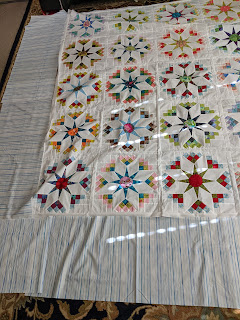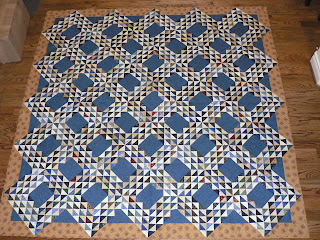"Everything can be taken from a man but one thing,
the last of the human freedoms
- to choose one's attitude in any given set of circumstances, to choose one's own way."
~Victor Frankl in Man's Search for Meaning
Quilting
Today seemed like a good time to review binding because frankly, I've gotten a bit lazy. There are many good videos on YouTube showing how to apply binding, turn the corners, and finish it off. In general I like this McCall's set of four videos but find they've missed an important step - waving edges. That happens when the binding length is not measured and fitted to each side.
It's easy to think the quilt is perfectly squared up but that's not always true. So cutting binding to the sum of the sides isn't enough to keep the edges flat. Sewing the binding to the quilt without comparing the side and the binding lengths allows them to stretch... even when using a walking foot.
A smarter way to attach the binding is to measure across the middle of the quilt in both directions and use those measurements for the sides. If the quilt is square like this one, measure both directions, take the average, and apply it to all four sides.
In this case, my "perfectly square quilt" was off by 1/8-inch. The average is 42.5 inches.
 |
Measuring across the quilt to determine
the length of the sides of binding
|
Insert a pin several inches from one end of the binding. In the photo below the pin is about ten inches from the end of the binding. {You can also mark the place with a pencil or marking pen.}
 |
| Start marking the binding with a pin |
Add another pin when you reach the average length {the one measured across the middle.} You will do this four times for a total of five pins in the binding. If your pins tend to fall out, you might prefer to simply mark them with a pencil. Just make sure you mark on the "top" so it will fold inside the binding.
 |
Insert another pin each time you reach the average length
|
Starting with the first pin line it up with the first quilt corner/edge. That extra ten inches will extend back over the "fourth" side. Pin the binding to the quilt at each corner until you return to the starting point with that fifth pin.
This isn't a good photo but the binding is pinned loosely to all four sides and overlaps the original extra bit here.
 |
Pin the binding on the fourth side
over the original extra
|
Go back to ease the quilt and the binding on each side with more pins. On the fourth side, pin the last overlapping binding but remember it won't all be sewn the first time. The two ends need to be fitted together. Mark where the binding ends meet and plan to leave some space to sew them together. Again, look at the YouTube videos for a method you like.
 |
Fold the original leader back
when pinning the binding in place
|
This post is a personal sticky note that I hope helps you, too.
Reading
Mary Robinette Kowal's latest installment of the Lady Astronaut series was my latest book. I find the the premise of this series very engaging. The Relentless Moon is the first story without Elma {the original Lady Astronaut}, who is on her way to Mars. In addition to a Martian base, humanity is creating a lunar base to evacuate more people. Post-Meteor life means women and Blacks have new opportunities but there have been several accidents that could ground the space program. Are they caused by minorities or by political extremists or are they the result of poor planning by the space program? There is evidence to support all these reasons.
Nicole Wargin, another of the first women astronauts and the wife of the governor of Kansas where the US government and space effort is headquartered, is sent to the moon again to help discover the truth. At fifty, she is intelligent, resourceful, and privileged but also experiences physical and mental issues - like a real person. Mary expands her book universe tremendously by developing the motivations and point of view of {previously} secondary characters.
Well researched, well written. I enjoy the twists that happen in this alternate world including how Mary addresses racial and gender equality.
Voting
Early voting begins today in Texas. Wherever you are, print a sample ballot; research the candidates and issues and take it with you to vote. VOTE UP THE BALLOT. That means research and vote each position on your ballot, not just the presidential race.
My ballot has already arrived at the election office. Where is yours?
Enjoy the day, Ann























































